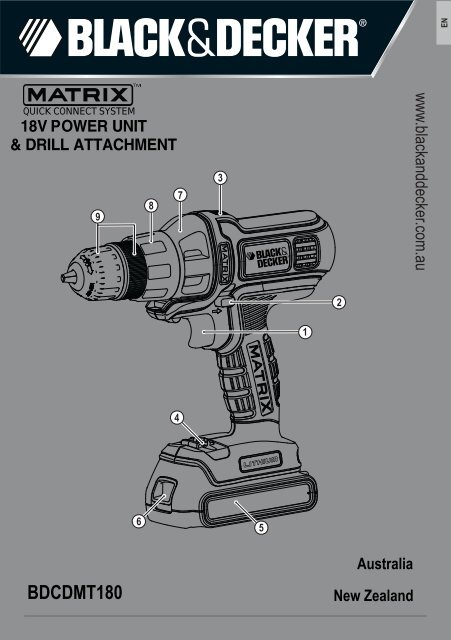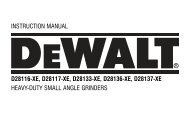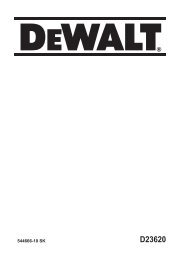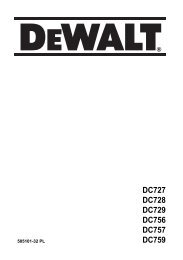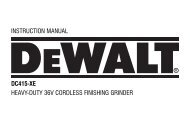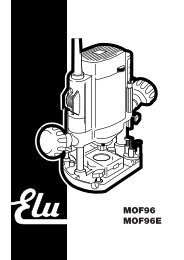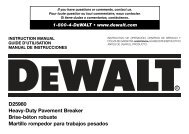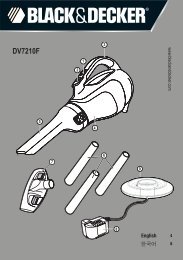Instruction Manual - Black & Decker
Instruction Manual - Black & Decker
Instruction Manual - Black & Decker
You also want an ePaper? Increase the reach of your titles
YUMPU automatically turns print PDFs into web optimized ePapers that Google loves.
QUICK CONNECT SYSTEM<br />
18V POWER UNIT<br />
& DRILL ATTACHMENT<br />
®<br />
www.blackanddecker.com.au<br />
BDCDMT180<br />
Australia<br />
New Zealand
5<br />
A<br />
B<br />
C<br />
D<br />
E<br />
2
(Original instructions)<br />
ENGLISH<br />
Intended use<br />
Your <strong>Black</strong> & <strong>Decker</strong> MATRIX multi-purpose tool has been<br />
designed for a wide range of DIY applications.<br />
Using the drill/screwdriver head , this tool is intended<br />
for screwdriving applications and for drilling in wood, metal<br />
and plastics.<br />
This tool is intended for consumer use only. Your <strong>Black</strong> &<br />
<strong>Decker</strong> charger has been designed for charging <strong>Black</strong> &<br />
<strong>Decker</strong> batteries of the type supplied with this tool.<br />
Safety instructions<br />
General power tool safety warnings<br />
@<br />
Warning! Read all safety warnings and all<br />
instructions. Failure to follow the warnings and<br />
instructions listed below may result in electric<br />
shock, fire and/or serious injury.<br />
Save all warnings and instructions for future reference.<br />
The term "power tool" in the warnings refers to your mains<br />
operated (corded) power tool or battery operated (cordless)<br />
power tool.<br />
1. Work area safety<br />
a. Keep work area clean and well lit. Cluttered or dark<br />
areas invite accidents.<br />
b. Do not operate power tools in explosive atmospheres,<br />
such as in the presence of flammable liquids, gases<br />
or dust. Power tools create sparks which may ignite the<br />
dust or fumes.<br />
c. Keep children and bystanders away while operating a<br />
power tool. Distractions can cause you to lose control.<br />
2. Electrical safety<br />
a. Power tool plugs must match the outlet. Never modify<br />
the plug in any way. Do not use any adapter plugs<br />
with earthed (grounded) power tools. Unmodified plugs<br />
and matching outlets will reduce risk of electric shock.<br />
b. Avoid body contact with earthed or grounded<br />
surfaces such as pipes, radiators, ranges and<br />
refrigerators. There is an increased risk of electric shock<br />
if your body is earthed or grounded.<br />
c. Do not expose power tools to rain or wet conditions.<br />
Water entering a power tool will increase the risk of<br />
electric shock.<br />
d. Do not abuse the cord. Never use the cord for<br />
carrying, pulling or unplugging the power tool. Keep<br />
cord away from heat, oil, sharp edges or moving<br />
parts. Damaged or entangled cords increase the risk of<br />
electric shock.<br />
e. When operating a power tool outdoors, use an<br />
extension cord suitable for outdoor use. Use of a cord<br />
suitable for outdoor use reduces the risk of electric shock.<br />
f. If operating a power tool in a damp location is<br />
unavoidable, use a residual current device (RCD)<br />
protected supply. Use of an RCD reduces the risk of<br />
electric shock.<br />
3. Personal safety<br />
a. Stay alert, watch what you are doing and use common<br />
sense when operating a power tool. Do not use a<br />
power tool while you are tired or under the influence<br />
of drugs, alcohol or medication. A moment of inattention<br />
while operating power tools may result in serious personal<br />
injury.<br />
b. Use personal protective equipment. Always wear eye<br />
protection. Protective equipment such as dust mask,<br />
non-skid safety shoes, hard hat, or hearing protection<br />
used for appropriate conditions will reduce personal<br />
injuries.<br />
c. Prevent unintentional starting. Ensure the switch is in<br />
the off-position before connecting to power source<br />
and/or battery pack, picking up or carrying the tool.<br />
Carrying power tools with your finger on the switch or<br />
energising power tools that have the switch on invites<br />
accidents.<br />
d. Remove any adjusting key or wrench before turning<br />
the power tool on. A wrench or a key left attached to a<br />
rotating part of the power tool may result in personal injury.<br />
e. Do not overreach. Keep proper footing and balance at<br />
all times. This enables better control of the power tool in<br />
unexpected situations.<br />
f. Dress properly. Do not wear loose clothing or<br />
jewellery. Keep your hair, clothing and gloves away<br />
from moving parts. Loose clothes, jewellery or long hair<br />
can be caught in moving parts.<br />
g. If devices are provided for the connection of dust<br />
extraction and collection facilities, ensure these are<br />
connected and properly used. Use of dust collection can<br />
reduce dust-related hazards.<br />
4. Power tool use and care<br />
a. Do not force the power tool. Use the correct power<br />
tool for your application. The correct power tool will do<br />
the job better and safer at the rate for which it was<br />
designed.<br />
b. Do not use the power tool if the switch does not turn it<br />
on and off. Any power tool that cannot be controlled with<br />
the switch is dangerous and must be repaired.<br />
3
ENGLISH<br />
(Original instructions)<br />
c. Disconnect the plug from the power source and/or the<br />
battery pack from the power tool before making any<br />
adjustments, changing accessories, or storing power<br />
tools. Such preventive safety measures reduce the risk of<br />
starting the power tool accidentally.<br />
d. Store idle power tools out of the reach of children and<br />
do not allow persons unfamiliar with the power tool or<br />
these instructions to operate the power tool. Power<br />
tools are dangerous in the hands of untrained users.<br />
e. Maintain power tools. Check for misalignment or<br />
binding of moving parts, breakage of parts and any<br />
other condition that may affect the power tools<br />
operation. If damaged, have the power tool repaired<br />
before use. Many accidents are caused by poorly<br />
maintained power tools.<br />
f. Keep cutting tools sharp and clean. Properly<br />
maintained cutting tools with sharp cutting edges are less<br />
likely to bind and are easier to control.<br />
g. Use the power tool, accessories and tool bits etc. in<br />
accordance with these instructions, taking into<br />
account the working conditions and the work to be<br />
performed. Use of the power tool for operations different<br />
from those intended could result in a hazardous situation.<br />
5. Battery tool use and care<br />
a. Recharge only with the charger specified by the<br />
manufacturer. A charger that is suitable for one type of<br />
battery pack may create a risk of fire when used with<br />
another battery pack.<br />
b. Use power tools only with specifically designated<br />
battery packs. Use of any other battery packs may create<br />
a risk of injury and fire.<br />
c. When battery pack is not in use, keep it away from<br />
other metal objects, like paper clips, coins, keys,<br />
nails, screws, or other small metal objects, that can<br />
make a connection from one terminal to another.<br />
Shorting the battery terminals together may cause burns<br />
or a fire.<br />
d. Under abusive conditions, liquid may be ejected from<br />
the battery; avoid contact. If contact accidentally<br />
occurs, flush with water. If liquid contacts eyes,<br />
additionally seek medical help. Liquid ejected from the<br />
battery may cause irritation or burns.<br />
6. Service<br />
a. Have your power tool serviced by a qualified repair<br />
person using only identical replacement parts. This<br />
will ensure that the safety of the power tool is maintained.<br />
Additional power tool safety warnings<br />
@<br />
Warning! Additional safety warnings for drills<br />
and impact drills<br />
u Wear ear protectors with impact drills. Exposure to<br />
noise can cause hearing loss.<br />
u Use auxiliary handles supplied with the tool. Loss of<br />
control can cause personal injury.<br />
u Hold power tool by insulated gripping surfaces when<br />
performing an operation where the cutting accessory<br />
may contact hidden wiring. Cutting accessory contacting<br />
a "live" wire may make exposed metal parts of the power<br />
tool "live" and could give the operator an electric shock<br />
u Hold power tool by insulated gripping surfaces when<br />
performing an operation where the fastener may<br />
contact hidden wiring. Fasteners contacting a "live" wire<br />
may make exposed metal parts of the power tool "live"<br />
and could give the operator an electric shock.<br />
u Never use a chisel accessory in rotary mode. The accessory<br />
will bind in the material and rotate the drill.<br />
u Use clamps or another practical way to secure and support<br />
the workpiece to a stable platform. Holding the work<br />
by hand or against your body leaves it unstable and may<br />
lead to loss of control.<br />
u Before drilling into walls, floors or ceilings, check for the<br />
location of wiring and pipes.<br />
u Avoid touching the tip of a drill bit just after drilling, as it<br />
may be hot.<br />
u The intended use is described in this instruction manual.<br />
The use of any accessory or attachment or performance<br />
of any operation with this tool other than those recommended<br />
in this instruction manual may present a risk of<br />
personal injury and/or damage to property.<br />
Safety of others<br />
u This appliance is not intended for use by persons (including<br />
children) with reduced physical, sensory or mental<br />
capabilities, or lack of experience and knowledge, unless<br />
they have been given supervision or instruction concerning<br />
use of the appliance by a person responsible for their<br />
safety.<br />
u Children should be supervised to ensure that they do not<br />
play with the appliance.<br />
4
(Original instructions)<br />
ENGLISH<br />
Residual risks.<br />
Additional residual risks may arise when using the tool which<br />
may not be included in the enclosed safety warnings. These<br />
risks can arise from misuse, prolonged use etc.<br />
Even with the application of the relevant safety regulations<br />
and the implementation of safety devices, certain residual<br />
risks can not be avoided. These include:<br />
u Injuries caused by touching any rotating/moving parts.<br />
u Injuries caused when changing any parts, blades or accessories.<br />
u Injuries caused by prolonged use of a tool. When using<br />
any tool for prolonged periods ensure you take regular<br />
breaks.<br />
u Impairment of hearing.<br />
u Health hazards caused by breathing dust developed when<br />
using your tool (example:- working with wood, especially<br />
oak, beech and MDF.)<br />
Vibration<br />
The declared vibration emission values stated in the technical<br />
data and the declaration of conformity have been measured<br />
in accordance with a standard test method provided by<br />
EN 60745 and may be used for comparing one tool with<br />
another. The declared vibration emission value may also be<br />
used in a preliminary assessment of exposure.<br />
Warning! The vibration emission value during actual use of<br />
the power tool can differ from the declared value depending<br />
on the ways in which the tool is used. The vibration level may<br />
increase above the level stated.<br />
When assessing vibration exposure to determine safety<br />
measures required by 2002/44/EC to protect persons regularly<br />
using power tools in employment, an estimation of vibration<br />
exposure should consider, the actual conditions of use and the<br />
way the tool is used, including taking account of all parts of the<br />
operating cycle such as the times when the tool is switched off<br />
and when it is running idle in addition to the trigger time.<br />
Labels on tool<br />
The following pictograms are shown on the tool:<br />
:<br />
Warning! To reduce the risk of injury, the user<br />
must read the instruction manual.<br />
Electrical safety<br />
Additional safety instructions for batteries and<br />
chargers<br />
Batteries<br />
u Never attempt to open for any reason.<br />
u Do not expose the battery to water.<br />
u Do not store in locations where the temperature may<br />
exceed 40 °C.<br />
u Charge only at ambient temperatures between 10 °C and<br />
40 °C.<br />
u Charge only using the charger provided with the tool.<br />
u When disposing of batteries, follow the instructions given<br />
in the section "Protecting the environment".<br />
p<br />
Do<br />
Chargers<br />
not attempt to charge damaged batteries.<br />
u Use your <strong>Black</strong> & <strong>Decker</strong> charger only to charge the battery<br />
in the tool with which it was supplied. Other batteries<br />
could burst, causing personal injury and damage.<br />
u Never attempt to charge non-rechargeable batteries.<br />
u Have defective cords replaced immediately.<br />
u Do not expose the charger to water.<br />
u Do not open the charger.<br />
u Do not probe the charger.<br />
$<br />
Electrical safety<br />
#<br />
The charger is intended for indoor use only.<br />
Your charger is double insulated; therefore no<br />
earth wire is required. Always check that the<br />
mains voltage corresponds to the voltage on the<br />
rating plate. Never attempt to replace the charger<br />
unit with a regular mains plug.<br />
u If the supply cord is damaged, it must be replaced by the<br />
manufacturer or an authorised <strong>Black</strong> & <strong>Decker</strong> Service<br />
Centre in order to avoid a hazard.<br />
5
ENGLISH<br />
(Original instructions)<br />
Features<br />
This tool includes some or all of the following features.<br />
1. Variable speed switch<br />
2. Forward/reverse slider<br />
3. Head release button<br />
4. Bit holder<br />
5. Battery<br />
6. Battery release button<br />
7. Drill/screwdriver head<br />
8. Torque adjustment collar<br />
9. Chuck<br />
Assembly<br />
Warning! Before assembly, remove the battery from the tool.<br />
Fitting and removing the battery (fig. A)<br />
u To fit the battery (5), line it up with the receptacle on the<br />
tool. Slide the battery into the receptacle and push until<br />
the battery snaps into place.<br />
u To remove the battery, push the release button (6) while at<br />
the same time pulling the battery out of the receptacle.<br />
Fitting and removing tool heads (fig. B)<br />
Warning! Care must be taken when fitting and removing<br />
heads. Moving parts may become hot during use.<br />
u Lock the tool by setting the forward/reverse slider (2) to<br />
the centre position.<br />
u To remove a tool head, depress the head release button<br />
(3) and take the head off the tool.<br />
u To fit a tool head, line it up with the tool as shown and<br />
push it onto the tool until it snaps into place.<br />
Fitting and removing a drill bit or screwdriver bit<br />
The drill/screwdriver head is fitted with a keyless chuck to<br />
allow for an easy exchange of bits.<br />
u Lock the tool by setting the forward/reverse slider (2) to<br />
the centre position.<br />
u Open the chuck (9) by turning the front part clockwise with<br />
one hand while holding the rear part with the other.<br />
u Insert the bit shaft into the chuck (9).<br />
u Firmly tighten the chuck (9) by turning the front part anticlockwise<br />
with one hand while holding the rear part with<br />
the other.<br />
u To remove the screwdriver bit from the bit holder, lift the bit<br />
from the recess.<br />
u To store the screwdriver bit, firmly push it into the holder.<br />
Use<br />
Warning! Let the tool work at its own pace. Do not overload.<br />
Warning! Before drilling into walls, floors or ceilings, check for<br />
the location of wiring and pipes.<br />
Charging the battery (fig. C)<br />
The battery needs to be charged before first use and whenever<br />
it fails to produce sufficient power on jobs that were easily<br />
done before. The battery may become warm while charging;<br />
this is normal and does not indicate a problem.<br />
Warning! Do not charge the battery at ambient temperatures<br />
below 10 °C or above 40 °C. Recommended charging temperature:<br />
approx. 24 °C.<br />
Note: The charger will not charge a battery if the cell<br />
temperature is below approximately 0 °C or above 40 °C.<br />
The battery should be left in the charger and the charger<br />
will begin to charge automatically when the cell temperature<br />
warms up or cools down.<br />
u To charge the battery (5), insert it into the charger (10).<br />
The battery will only fit into the charger in one way. Do<br />
not force. Be sure that the battery is fully seated in the<br />
charger.<br />
u Plug in the charger and switch on at the mains.<br />
The charging indicator (11) will flash green continuously<br />
(slowly).<br />
The charge is complete when the charging indicator (11)<br />
lights green continuously. The charger and the battery can be<br />
left connected indefinitely with the LED illuminated. The LED<br />
will change to flashing green (charging) state as the charger<br />
occasionally tops off the battery charge. The charging indicator<br />
(11) will be lit as long as the battery is connected to the<br />
plugged-in charger.<br />
u Charge discharged batteries within 1 week. Battery life will<br />
be greatly diminished if stored in a discharged state.<br />
Leaving the battery in the charger<br />
The charger and battery pack can be left connected with the<br />
LED glowing indefinitely. The charger will keep the battery<br />
pack fresh and fully charged.<br />
Charger diagnostics<br />
If the charger detects a weak or damaged battery, the charging<br />
indicator (11) will flash red at a fast rate. Proceed as<br />
follows:<br />
u Re-insert the battery (5).<br />
u If the charging indicators continues flashing red at a fast<br />
rate, use a different battery to determine if the charging<br />
process works properly.<br />
u If the replaced battery charges correctly, the original<br />
battery is defective and should be returned to a service<br />
centre for recycling.<br />
6
(Original instructions)<br />
ENGLISH<br />
u If the new battery gives the same indication as the original<br />
battery, take the charger to be tested at an authorised<br />
services centre.<br />
Note: It may take as long as 60 minutes to determine that<br />
the battery is defective. If the battery is too hot or too<br />
cold, the LED will alternately blink red, fast and slow, one<br />
flash at each speed and repeat.<br />
Selecting the torque or drill position (fig. D)<br />
This tool is fitted with a collar to set the torque for tightening<br />
screws.<br />
u For drilling, set the collar (8) to the drilling position by<br />
aligning the symbol with the marking (12).<br />
u For screwdriving, set the collar to the desired setting.<br />
u If you do not yet know the appropriate setting, proceed as<br />
follows:<br />
t Set the collar (8) to position 1.<br />
t Tighten the first screw.<br />
t If the clutch ratchets before the desired result is<br />
achieved, increase the collar setting and continue<br />
tightening the screw. Repeat until you reach the correct<br />
setting.<br />
Selecting the direction of rotation (fig. E)<br />
For drilling and tightening screws,<br />
use forward (clockwise) rotation. For loosening screws or<br />
removing a jammed drill bit, use reverse (counterclockwise)<br />
rotation.<br />
u To select forward rotation, push the forward/reverse slider<br />
(2) to the left.<br />
u To select reverse rotation, push the forward/reverse slider<br />
to the right.<br />
u To lock the tool, set the forward/reverse slider into the<br />
centre position.<br />
Drilling/screwdriving<br />
u Select forward or reverse rotation using the forward/reverse<br />
slider (2).<br />
u To switch the tool on, press the variable speed switch (1).<br />
The tool speed depends on how far you press the switch.<br />
u To switch the tool off, release the variable speed switch.<br />
Hints for optimum use<br />
u Use HSS drill bits when drilling in metal.<br />
u Use masonry bits when drilling in soft masonry.<br />
u Use a lubricant when drilling metals other than cast iron<br />
and brass.<br />
u Make an indentation using a centre punch at the centre of<br />
the hole to be drilled in order to improve accuracy.<br />
Screwdriving<br />
u Always use the correct type and size of screwdriver bit.<br />
u If screws are difficult to tighten, try applying a small<br />
amount of washing liquid or soap as a lubricant.<br />
u Always hold the tool and screwdriver bit in a straight line<br />
with the screw.<br />
Accessories<br />
The performance of your tool depends on the accessory used.<br />
<strong>Black</strong> & <strong>Decker</strong> and Piranha accessories are engineered to<br />
high quality standards and designed to enhance the performance<br />
of your tool. By using these accessories you will get the<br />
very best from your tool.<br />
Maintenance<br />
Your <strong>Black</strong> & <strong>Decker</strong> corded/cordless appliance/tool has been<br />
designed to operate over a long period of time with a minimum<br />
of maintenance. Continuous satisfactory operation depends<br />
upon proper tool care and regular cleaning.<br />
Warning! Before performing any maintenance on corded/<br />
cordless power tools:<br />
u Switch off and unplug the appliance/tool.<br />
u Or switch off and remove the battery from the appliance/<br />
tool if the appliance/tool has a separate battery pack.<br />
u Or run the battery down completely if it is integral and then<br />
switch off.<br />
u Unplug the charger before cleaning it. Your charger does<br />
not require any maintenance apart from regular cleaning.<br />
u Regularly clean the ventilation slots in your appliance/tool/<br />
charger using a soft brush or dry cloth.<br />
u Regularly clean the motor housing using a damp cloth. Do<br />
not use any abrasive or solvent-based cleaner.<br />
u Regularly open the chuck and tap it to remove any dust<br />
from the interior (when fitted).<br />
Drilling<br />
u Always apply a light pressure in a straight line with the drill<br />
bit.<br />
u Just before the drill tip breaks through the other side of the<br />
workpiece, decrease pressure on the tool.<br />
u Use a block of wood to back up workpieces that may<br />
splinter.<br />
u Use spade bits when drilling large diameter holes in wood.<br />
7
ENGLISH<br />
(Original instructions)<br />
Protecting the environment<br />
Z<br />
Separate collection. This product must not be<br />
disposed of with normal household waste.<br />
needs replacement, or if it is of no further use to you, do not<br />
dispose of it with household waste. Make this product available<br />
for separate collection.<br />
z<br />
Separate collection of used products and packaging<br />
allows materials to be recycled and used again.<br />
Re-use of recycled materials helps prevent<br />
environmental pollution and reduces the demand<br />
for raw materials.<br />
Local regulations may provide for separate collection of electrical<br />
products from the household, at municipal waste sites or<br />
by the retailer when you purchase a new product.<br />
<strong>Black</strong> & <strong>Decker</strong> provides a facility for the collection and<br />
recycling of <strong>Black</strong> & <strong>Decker</strong> products once they have reached<br />
the end of their working life. To take advantage of this service<br />
please return your product to any authorised repair agent who<br />
will collect them on our behalf.<br />
You can check the location of your nearest authorised repair<br />
the address indicated in this manual. Alternatively, a list of<br />
authorised <strong>Black</strong> & <strong>Decker</strong> repair agents and full details of our<br />
after-sales service and contacts are available on the Internet<br />
at: www.2helpU.com<br />
Batteries<br />
Z<br />
Run the battery down completely, then remove it<br />
from the tool.<br />
NiCd, NiMH and Li-Ion batteries are recyclable. Take them<br />
to any authorised repair agent or a local recycling station.<br />
Technical data<br />
18V MATRIX UNIT<br />
Voltage V DC<br />
BDCDMT180<br />
18<br />
Drill / Screwdriver<br />
No-load speed min -1 BDCMTDD<br />
0-800<br />
Max. torque<br />
(PTI Rating)<br />
Nm<br />
44<br />
Chuck capacity mm 10<br />
Max. drilling capacity<br />
Steel mm 10<br />
Wood mm 25<br />
Battery<br />
BL1518<br />
Voltage V DC 18<br />
Capacity Ah 1.5<br />
Type<br />
Li-Ion<br />
Charger<br />
Input voltage V AC 230<br />
Output voltage V DC 20<br />
Current A 2.0<br />
Approx. charge<br />
time<br />
min<br />
40<br />
Level of sound pressure according to EN 60745:<br />
Sound pressure (L pA<br />
) 77.1 dB(A), uncertainty (K) 3 dB(A)<br />
Sound power (L WA<br />
) 88.1 dB(A), uncertainty (K) 3 dB(A)<br />
Vibration total values (triax vector sum) according to EN 60745:<br />
Drilling into metal (a h, D<br />
) < 2.5 m/s 2 , uncertainty (K) 1.5 m/s 2<br />
Screwdriving without impact (a h<br />
) < 2.5 m/s 2 , uncertainty (K) 1.5 m/s 2<br />
8
(Original instructions)<br />
ENGLISH<br />
9
ENGLISH<br />
(Original instructions)<br />
10
(Original instructions)<br />
ENGLISH<br />
11
Australia & New Zealand<br />
Stanley <strong>Black</strong> & <strong>Decker</strong><br />
82 Taryn Drive, Epping, VIC 3076 Australia<br />
Tel.1800 444 224 (Aust) or Tel. 0800 339 258 (NZ)<br />
90589571 REV-0 07/2012


